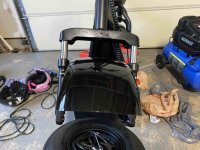Hello,
I am a new owner of a Mototec Knock Out scooter, as seen here:
https://www.urbanscooters.com/products/mototec-knockout-48v-1000w-electric-scooter
Since I bough it a month or so ago, I have upgraded from the SLA 48v setup to a LiFe04 60v setup (soon to be 72v), upgraded the motor to a 2000w version from the same manufacturer, and installed a 2000w controller. I am getting faster speeds (about 28mph) with the 2000w motor, but of course not fast enough yet, so I am going to 72v.
This is the motor I installed in lieu of the stock one:
https://www.uumotor.com/ws/p/18x9-5-8225-55-8-60v-1000w1500w-brushless-dc-fat-tire-motor/
So, now, my challenge. I decided that maybe two motors (2wd) would be better than one. It probably won't help me on flat ground except maybe for acceleration, but it should improve my uphill performance. So, I ordered two of the 2000w motor, and planned to install one in place of the front wheel.
The problem is, the integrated axle in the hub motor is too long for the fork in the front (I am new to this so pardon the terminology). Photos attached. It appears to be too long by almost exactly the length of the rectangular portion on the end of the axle. Would it be safe/advisable to just cut this off with an angle grinder? The brake fits into the caliper properly on the left side, but leaves a good bit jutting out on the right. Alternatively, is there any other way to mount this?
Thanks for any advice - even if it's "don't do that"


I am a new owner of a Mototec Knock Out scooter, as seen here:
https://www.urbanscooters.com/products/mototec-knockout-48v-1000w-electric-scooter
Since I bough it a month or so ago, I have upgraded from the SLA 48v setup to a LiFe04 60v setup (soon to be 72v), upgraded the motor to a 2000w version from the same manufacturer, and installed a 2000w controller. I am getting faster speeds (about 28mph) with the 2000w motor, but of course not fast enough yet, so I am going to 72v.
This is the motor I installed in lieu of the stock one:
https://www.uumotor.com/ws/p/18x9-5-8225-55-8-60v-1000w1500w-brushless-dc-fat-tire-motor/
So, now, my challenge. I decided that maybe two motors (2wd) would be better than one. It probably won't help me on flat ground except maybe for acceleration, but it should improve my uphill performance. So, I ordered two of the 2000w motor, and planned to install one in place of the front wheel.
The problem is, the integrated axle in the hub motor is too long for the fork in the front (I am new to this so pardon the terminology). Photos attached. It appears to be too long by almost exactly the length of the rectangular portion on the end of the axle. Would it be safe/advisable to just cut this off with an angle grinder? The brake fits into the caliper properly on the left side, but leaves a good bit jutting out on the right. Alternatively, is there any other way to mount this?
Thanks for any advice - even if it's "don't do that"



